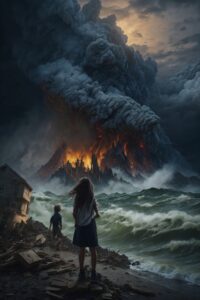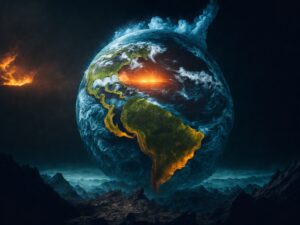The World’s Deadliest and Scariest Natural Disasters
Nature’s fury is undeniable. It can be awe-inspiring and humbling, reminding us of our tiny place in the vast universe.
While we marvel at the power of nature, we must also recognize its potential for devastation.
This article delves into the scariest natural disasters that have struck the world, taking a closer look at the deadliest events that have changed the course of history.
Read on to understand the terrifying natural phenomena that have claimed countless lives and learn from past tragedies to ensure a safer future.
Here’s a heat map showcasing areas most at risk for certain disasters:

- The darker shades represent higher risk levels. For instance, Asia has a notably high risk for Earthquakes, Hurricanes, and Floods.
- Australia shows a higher risk for Wildfires, which is consistent with the recent history of bushfires in the region.
- Africa has a higher risk for Droughts and Floods, emphasizing the continent’s vulnerability to climate-related disasters.
This visualization provides a comprehensive view of regional vulnerabilities to specific disasters, helping readers understand which areas are more prone to certain risks.
What Makes a Natural Disaster Terrifying?
When we talk about a terrifying natural disaster, it’s not just about the magnitude or the number of deaths. It’s about the unpredictability, the vast scale, and the sheer power that these natural events showcase.
Catastrophes such as earthquakes, hurricanes, and tsunamis happen anywhere and can affect millions of lives.
The scariest natural disasters are those that leave a lasting impact, making them unforgettable.
Here Is The 9 Terrifying Natural Disasters In History
Throughout history, nature has shown its might through various catastrophic events. From the 1556 Shaanxi earthquake to the 1931 China floods and the 2004 Indian Ocean tsunami, these events remind us of the unpredictability and power of nature.
1. What Makes Earthquakes So Terrifying?
Earthquakes, or quakes as they’re sometimes called, are one of the most unpredictable natural disasters that occur.
The sudden shaking of the earth’s crust, often caused by tectonic plate movements, can result in immense damage. The 1556 Shaanxi earthquake in China remains the world’s deadliest, killing approximately 830,000 people.
More recently, the 7.0 magnitude quake that hit Port-au-Prince, Haiti, in 2010 resulted in a death toll exceeding 160,000.
Factors like the Richter scale, aftershocks, and the infamous Ring of Fire provide context to the catastrophe earthquakes can bring.
2. Why Are Hurricanes Among the Deadliest Natural Disasters?
Hurricanes, often characterized by strong winds, heavy rainfall, and storm surge, can wreak havoc in their path.
The Great Galveston Storm of 1900 remains the deadliest hurricane in U.S. history, with an estimated number of deaths between 6,000 and 12,000.
The National Oceanic and Atmospheric Administration (NOAA) often monitors these cyclonic storms, which can have wind speeds exceeding 155 miles per hour. Understanding their formation and patterns is crucial for disaster preparedness.
3. How Tsunamis Have Changed World History?
Spawned typically by underwater earthquakes or volcanic eruptions, tsunamis have led to catastrophic loss of life.
The 2004 Indian Ocean tsunami stands out as one of the world’s deadliest, killing at least 230,000 people across 14 countries.
The massive waves, sometimes reaching heights of over 100 feet, can engulf entire coastlines, leaving destruction in their wake.
4. Floods in History: Which Were the Deadliest?
Floods, often a result of prolonged rainfall or broken dams, have caused significant fatalities.
The 1931 China floods along the Yangtze, Yellow, and Huai rivers resulted in a staggering death toll where about 1.5 to 4.5 million people died.
Understanding why flooding occurs and the devastating impacts of this natural disaster can help in future risk mitigation.
5. Tornadoes: Nature’s Furious Funnel
Tornadoes, with their iconic funnel shape, are nature’s violent windstorms.
Formed from powerful thunderstorms, they can achieve wind speeds of up to 300 miles per hour. The funnel touches down and destroys everything in its path.
While they can happen anywhere, certain regions, especially in the U.S, are more prone to these terrifying natural whirlwinds.
6. Volcanic Eruptions: Nature’s Fiery Spectacle
Volcanic eruptions occur when there’s a sudden release of energy from below the Earth’s crust. This results in the expulsion of lava, ash, and gases.
The eruption of the Tambora volcano in 1815 is one of the deadliest, leading to the “Year Without a Summer” and subsequent famine.
With over 1,500 active volcanoes worldwide, understanding their patterns and potential for eruption is essential.

7. Landslides: The Silent Killers
Often triggered by heavy rainfall, earthquakes, or volcanic activity, landslides can bury entire communities under rock, mud, and debris.
Their unpredictability and swift nature make them particularly deadly, often leaving little time for evacuation.
8. Wildfires: Nature’s Blazing Fury
Wildfires, or forest fires, are uncontrolled fires that spread rapidly, fueled by dry weather, wind, and flammable vegetation.
They can burn thousands of acres of land, destroying homes and wildlife habitats in their path.
Climate change has led to an increase in the frequency and intensity of these fires.
9. Typhoons vs. Cyclones: What’s the Difference?
Both typhoons and cyclones are tropical storms, but the primary distinction lies in their location.
While typhoons occur in the Northwest Pacific region, cyclones happen in the South Pacific and Indian Ocean.
The Bhola cyclone of 1970 in East Pakistan (now Bangladesh) remains the deadliest, with over 500,000 people losing their lives.
Summary Of The Scariest Natural Disaster?
| Type Of Disasters | Description |
|---|---|
| Earthquake | Sudden shaking of the ground caused by tectonic movements. |
| Hurricane/Typhoon/Cyclone | Massive storm systems characterized by strong winds and heavy rainfall. |
| Tsunami | Large ocean waves generated by underwater disturbances, often earthquakes. |
| Tornado | Violently rotating columns of air in contact with both the ground and a cloud. |
| Volcanic Eruption | The explosion of magma from beneath the Earth’s crust. |
| Flood | Overflow of water onto normally dry land. |
| Wildfire | Uncontrolled fires burning in wildland areas. |
| Landslide | The downward movement of rock and soil due to gravity. |
Preparing for Natural Disasters: How Can We Stay Safe?
While we cannot prevent natural disasters, understanding their patterns and potential impact is key to minimizing risk.
Investing in early warning systems, building resilient infrastructure, and educating communities about evacuation procedures can save countless lives.
What Are the Essential Items You Need for Natural Disasters Situations?
- Water and non-perishable food items
- First aid kit
- Flashlights and extra batteries
- Multi-tool or knife
- Warm clothing and blankets
- Important documents and cash
- Portable phone charger
- Local maps
- Hygiene products
- Fire-starting tools
- Essential survival gear
- Knowledge on survival foods
- Understanding the challenges faced by preppers
- Distinguishing between survival and bushcraft

Key Takeaways:
- Earthquakes, while unpredictable, have left a lasting mark on human history, with the 1556 Shaanxi quake being the most devastating.
- Hurricanes, especially the Great Galveston Storm, highlight the importance of understanding and monitoring cyclonic patterns.
- Tsunamis, like the 2004 Indian Ocean tragedy, emphasize the need for coastal preparedness.
- Floods, especially the 1931 China floods, remain among the deadliest natural disasters in world history.
- Tornadoes, with their ferocious funnels, can cause immense destruction in mere minutes.
- Volcanic eruptions, such as the Tambora event, show nature’s potential to alter global climates.
- Landslides, while less frequent, can be silently devastating.
- Wildfires emphasize the importance of environmental conservation and climate change mitigation.
- Understanding the nuances between typhoons and cyclones can lead to better disaster response.
- Preparation and education are our best defenses against the unpredictable wrath of nature.
Here’s a visualization illustrating the preparation and education levels for various disasters:

- Earthquakes: While a significant portion of the population has a high level of preparedness, there’s still a noticeable percentage with only a moderate or low level of readiness.
- Hurricanes: A combined majority of the population has high to very high preparation levels, reflecting awareness and readiness for this kind of disaster.
- Floods: The preparation levels for floods are fairly distributed, with a slight lean towards high preparedness.
- Wildfires: The data indicates an equal emphasis on moderate and high levels of preparation, with lesser attention at the very high preparedness level.
This chart emphasizes the need for continuous education and awareness campaigns, especially for disasters where the population’s preparedness is not at optimal levels.
FREQUENTLY ASKED QUESTIONS
- Why do natural disasters occur?
Natural disasters are a result of the Earth’s natural processes. - How often do natural disasters happen?
The frequency varies, but some, like earthquakes, can happen every day, while others, like tsunamis, are less frequent. - What’s the difference between a hurricane, typhoon, and cyclone?
They are essentially the same phenomenon but are named differently based on their location.
I’m Alex, the author behind True Survivalist. As a survival enthusiast myself, I’ve created this website to serve as a valuable resource for fellow survivalists and preppers. Whether it’s understanding survival situations, emergency preparedness, or finding the right survival gear, I’ve got you covered. Through a series of informative guides, I aim to provide answers to commonly asked questions, debunk common myths, and help you avoid common mistakes. At True Survivalist, I believe in equipping you with the knowledge and tools you need to be prepared for any survival scenario. Join me on this journey of self-reliance and resilience.
